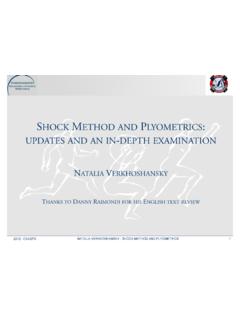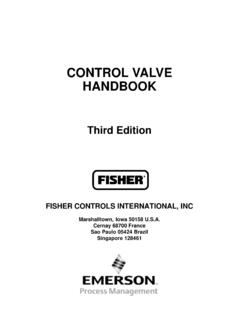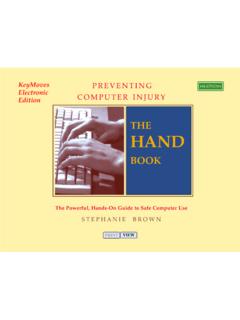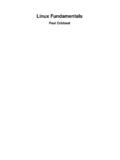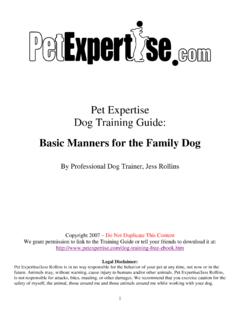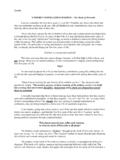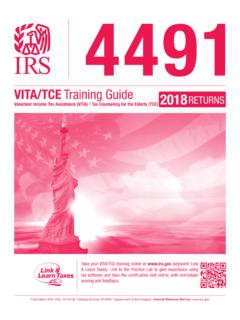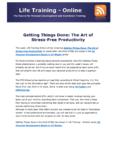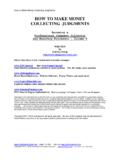Transcription of Published by Verkhoshansky SSTM 2011 – Rome, Italy
1 YYUURRII VVEERRKKHHOOSSHHAANNSSKKYY NNAATTAALLIIAA VVEERRKKHHOOSSHHAANNSSKKYY SSPPEECCIIAALL SSTTRREENNGGTTHH TTRRAAIINNIINNGG MMAANNUUAALL FFOORR CCOOAACCHHEESS Published by Verkhoshansky SSTM 2011 Rome, Italy Special Strength training Manual for Coaches Copyright: Yuri Verkhoshansky , Natalia Verkhoshansky Published by Verkhoshansky SSTM All rights reserved. No part of this book may be reproduced, stored in any electronic format or other retrieval system, or transmitted in any form, by any means, including mechanical, photocopy, recording and may not be used in any form for commercial purposes without the prior written permission of the authors. PREFACE IIIPREFACE OF YURI Verkhoshansky Dear reader, the Special Strength training presented in this manual is mainly addressed to coaches of Olympic sports athletes; it is also useful for coaches of strength & condition in all those sports in which it is necessary to have strength and high efficiency of movement.
2 I was a coach for many years, and still am in my mind and in my heart; I understand a coach s prob-lems very well and so, with this manual, I would like to share my knowledge and experience. The initial idea came to me when I discovered that in many Western countries bodybuilding training methods were used to improve the specific strength preparedness of athletes in Olympic sports disci-plines. This came as surprise to me. There is a fundamental difference between the training of Olym-pic sports athletes and bodybuilders: the final aim of bodybuilding is the perfection of body shape; the final aim in Olympic sports is the perfection of body movements. Bodybuilding methods were created for perfecting body harmony, elegance of pose and art of muscle control. Bodybuilding methods are ideal for these purposes; they are very fine detailed and scientifi-cally justified. However, these methods involve mechanisms of the muscle contractile function which are not specific for the Olympic sports.
3 In Olympic sports, where victory hinges on speed of move-ment, power of muscular effort and physical endurance, the strength training entirely based on the use of bodybuilding methods cannot be effective. Special Strength training for Olympic sports disciplines is based on different principles from those used in bodybuilding. Many of these principles were developed in the Soviet Union towards the end of the last century when I was more actively involved in the field of sports training . I have written this manual in order to set out these principles in an attempt to inform Western coaches and facilitate their understanding of Special Strength training Methodology. What are the distinctive features of Special Strength training Methodology? The main distinctive feature of the Special Strength training in Olympic sports is that, in the training process, the resistance exercises are focused not simply on the development of muscle strength: above all, they intensify the functional activity of the human motor system and, as consequence, the func-tional activity of the body s physiological system.
4 Correctly applied, Special Strength training changes the morpho-functional characteristics of the athlete s body, allowing carrying out his specific competi-tion exercise with higher power output. This is at the basis of improving athlete s technical-tactical mastery and physical performance. SST, therefore, is not simply a useful extra; it is an integral part of the whole training system in every sports discipline; it is one of the main contributory factors towards excellence in sports achievement. Often we may observe an unjustifiable opposition towards resistance exercises among coaches and in the literature. It is believed that resistance exercises negatively influences speed of movement. How-ever, the training effect of every exercise depends on the methods. When the SST methods are used correctly, resistance exercises promote not only an increase in speed, but they also perfect coordina-tion, motor reaction, quickness and frequency of movement, the ability to relax muscles and increase Local Muscular Endurance and Maximal Anaerobic Power.
5 Another important aspect to point out is that the SST is characterized by the use of training means in-tegrated into a system. In the past, the coaches were searching for the best exercise which could as-sure an easy way in achieving the higher increase in athlete s performance. Later, it was understood Preface IV that the single exercise cannot assure by itself the best increase in specific performance, but that it can be achieved by a group of different exercises integrated in a system. In this manual, the readers will find useful information about how such training means system could be created. Integrating the training means into a system inevitably requires that the coach has to know the meth-odological principles of the training process organization. I have tried to transfer, in a concise way, my knowledge of these principles so that this manual can be a tool to develop a rational SST programs and also a tool to organize a training process as whole with the optimal use of athlete s time and en-ergy.
6 Even though the contents of this manual are mainly addressed to Olympic sports athletes, they are also useful to coaches working with young athletes. The training of young athletes is aimed not only towards the improvement of their performance in current competitions, but also, and above all, to their preparation for highly intensive and specialized training in the future. Besides these recommenda-tions, coaches can see what is to be expected of young athletes in the future, gradually preparing them in advance, using the time available constructively. Why did I decide to publish a second edition of the manual? After the first edition was Published , I received many questions, many of which showed me the diffi-culties Western readers had in understanding the practical application of SST. Theoretical explanation was lacking in the old edition, as consequence of my assumption that readers were already familiar with all the theoretical aspects at the basis of SST programs.
7 For this reason I decided to revise the book content entirely and publish a new edition in which the methodological fundamentals of the SST would be presented not only in two phrases, like the first edition, but they would be described in a clearer and more detailed form. Furthermore, to respond to the most frequently asked questions, I have completely revised the section of the book explaining the organization of the training process with more detailed descriptions of the Block training System. For this new edition I have relied on the help of my daughter Natalia. She is the person who understands my work best. She grew up in a Track & Field stadium, between the jumping field where I was coaching, and the throwing field where her mother was coaching. She studied at the Central State Institute of Physical Educa-tion and Sport and worked on her baccalaureate thesis in my laboratory where she was a witness to many of my burning ideas, many of which she based her PhD thesis on; she participated in a number of scientific discussions, defending these ideas, putting them into practice as a coach of the Soviet national female tennis team in the1980s and the Italian national female bas-ketball team and junior national fencing team in the late 1990s.
8 She is the author of several scientific articles and a professor at the Rome University Tor Vergata. She has given her own significant professional contribution to this work; in fact several new sections of the manual come from her previous publications or material used at the University where she teaches. For these reasons she is the co-author of this edition. We have tried to standardize and bring uniformity to the terminology and to describe the SST means, methods, and training programs in more detail; we have also added new training programs which were not in the first edition. The result is a completely new book. PREFACE VFinal remarks All the SST programs illustrated in the manual came out from experiments and have been successfully employed in sports practice by Olympic sport athletes. On the basis of these proven programs (and using the manual as a guide) it is believed that a coach can work out his own program for any sports discipline.
9 Some of the programs are really strenuous; they were created for top level athletes. If you do not be-long to this category of athletes, please pay attention to the volume of loads; do not use them or, at least, try to start at the lowest level of loads indicated. Be careful and I am sure that success will be yours. Sincerely yours, EDITOR S NOTE: The main part of the book was already finished when Prof. Verkhoshansky passed away; this preface is proposed as it was written by him. TABLE OF CONTENT XXITABLE OF CONTENT PREFACE OF YURI PREFACE OF NATALIA TABLE OF XXI 1. METHODOLOGICAL FOUNDATIONS OF SPECIAL STRENGTH SPORT RESULT AND FACTORS DETERMINING ITS 28 SPORT RESULT AS POWER OUTPUT OF COMPETITION 28 DETERMINING FACTORS IN INCREASING THE POWER OUTPUT OF COMPETITION 29 SST ROLE IN THE training 31 MAIN COMPONENTS OF training 31 SST AND INCREASING MOTOR 32 SST AND IMPROVING ATHLETE S SKILL TO RATIONALLY USE MOTOR 34 TASKS OF SST.
10 38 IMPROVING ATHLETE S STRENGTH 38 IMPROVING WORKING EFFECT OF 38 BASIC STRENGTH 40 STRENGTH CAPABILITIES RELATED TO THE REGIME OF MUSCULAR 41 STRENGTH 44 INTENSIFICATION OF MUSCLES WORK IN SPECIFIC 45 APPLYING SST IN training 46 GENERAL CHARACTERISTIC OF training MEANS AND training 46 GENERAL CHARACTERISTICS OF SST 48 GENERAL PRINCIPLES TO FOLLOW IN SELECTING SST 51 PRINCIPLE OF DYNAMIC 52 PRINCIPLE OF INTEGRATION OF training MEANS IN A 54 RULES OF APPLING SST MEANS IN training 57 RULE ONE: FORMULATING MOTOR TASK BEFORE EXECUTING SST 57 RULE TWO: MAINTAINING SCHEDULED LENGTH OF REST INTERVALS USING ACTIVE 58 RULE THREE: USING SST MEANS IN SPECIALLY ORGANIZED training SESSIONS OR S 60 RULE FOUR: KEEPING-UP training POTENTIAL OF SST 60 RULE FIVE: INCREASING THE SPECIFICITY OF SST MEANS training STIMULI 61 GUIDELINES FOR PLANNING SST .. 62 64 2. SST MEANS AND METHODS: RESISTANCE GENERAL CHARACTERISTICS OF RESISTANCE EXERCISES USED IN 67 DYNAMIC 69 METHODS OF USING DYNAMIC 69 MAXIMAL EFFORT 70 REPEAT-SERIAL 71 INTERVAL-SERIAL 72 REGIMES OF DYNAMIC EXERCISES 73 DYNAMIC EXERCISES EXECUTED WITH DIFFERENT MOVEMENT 74 DYNAMIC EXERCISES EXECUTED ONLY IN OVERCOMING OR YIELDING 75 ISOKINETIC 78 ISOMETRIC 81 Table of content XXII RESISTANCE EXERCISES IN COMBINED 83 STATIC-DYNAMIC 83 QUASI-ISOMETRIC 84 EXPLOSIVE STATIC-DYNAMIC 84 SLOW DYNAMIC EXERCISES WITH REDUCED AMPLITUDE OF 85 SHOCK 86 3.

